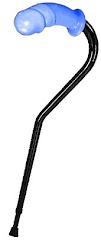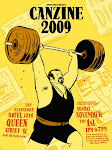Saturday, May 16, 2009
Wen-Do self-defence worth defending
 Genevieve Weigel was skipping class, riding the deserted subway back and forth between Kipling and Kennedy when three older male teens entered her car. One sat beside her. When he asked the 15-year-old for her phone number she didn’t feel threatened, but then he placed his hand on her thigh.
Genevieve Weigel was skipping class, riding the deserted subway back and forth between Kipling and Kennedy when three older male teens entered her car. One sat beside her. When he asked the 15-year-old for her phone number she didn’t feel threatened, but then he placed his hand on her thigh.Weigel shoved it off and rose to leave, standing taller than the trio. When the groper blocked her way and told her she wasn’t going anywhere she responded with the angry, gut wrenching yell she learned in Wen-Do. “Back off!” She struck him in the gut and he buckled to the floor.
Another guy wrapped his arms around her from behind. She instinctively shoved her body backwards, smashing him into the connecting subway door, and rammed her heel up into his groin. He collapsed. The third did nothing as she pressed the yellow emergency strip, the doors closing behind her as she walked out of the subway car, which had just arrived at a station. Shaken, she told the conductor what had occurred, and left.
Weigel, who served as this year’s events coordinator for Ryerson’s Women’s Centre, took her first Wen-Do Women’s Self Defence class when she was 12-years old.
What she experienced on public transit is the kind of success story that women share in Wen-Do.
Growing up she was usually stronger than the boys in her classes and often beat them in arm wrestling matches. When she was told that girls are weaker than boys she knew otherwise. “That always seemed like bullshit to me,” said Weigel.
Wen-Do exposed Weigel to her first feminist framework. “It was almost a revelation, like ‘Oh my God, I’m not by myself in this, and women are powerful and I knew somebody knew that,” she said loudly, her crimson lips parting in a broad smile.
Wen-Do originated in 1972 and is Canada’s longest running women’s self defence organization, as well as a registered charity. It was developed in Toronto by Ned and Ann Paige in response to the murder of Catherine Genovese in New York, who was stabbed and killed in 1964 within earshot of 38 neighbours, none of which called the police.
Wen-Do is endorsed by the Toronto Rape Crisis Centre and taught entirely by women, for women and girls (ages 10 and up) of all ages, sizes, physical and mental abilities. Physical and verbal techniques are interspersed with open discussion of violence against women and girls from an anti-oppressive, feminist perspective. Wen-Do emphasizes three goals: awareness, avoidance and action.
Deb Chard has been teaching Wen-Do full-time for 20 years, and taught Weigel’s first introductory course. She explains that self-defence means surviving and doesn’t always require punching or kicking.
 She leans forward, elbows resting on her knees, her pale blonde hair short and textured. “We’re looking at doing the least amount of self defence possible to run away,” she said, hands clasped, eyes fixed on each of us intently. “That’s what this is all about. I hope I never have to do this but these are some tools that I have in my tool box.”
She leans forward, elbows resting on her knees, her pale blonde hair short and textured. “We’re looking at doing the least amount of self defence possible to run away,” she said, hands clasped, eyes fixed on each of us intently. “That’s what this is all about. I hope I never have to do this but these are some tools that I have in my tool box.”After centuries of being told certain outfits and behaviour cause harassment and abuse women accept it as truth, said Chard. It’s common to hear, “But I was asking for it.” If you wear those revealing clothes, drink, or go out alone late at night and something happens it’s your fault. From childhood we are taught to modify our behaviour but in Wen-Do we discuss how skimpy skirts have nothing to do with it.
“Women have been raped in every imaginable article of clothing that you can think of,” said Chard. Clothing becomes the justification, diverting attention from where the real responsibility lies.
 Chard explains that when womanized men experience sexual assault in prison it indicates the reality of rape power dynamics over a group. Suggesting that low cut prison outfits instigate rape is ridiculous. If we can understand this about men, why can’t we understand it about women?
Chard explains that when womanized men experience sexual assault in prison it indicates the reality of rape power dynamics over a group. Suggesting that low cut prison outfits instigate rape is ridiculous. If we can understand this about men, why can’t we understand it about women?Our Wen-Do instructor Denise Handlarski is lying on her back as a woman in a loose, pink t-shirt is bent over the face, straddling her waist and clasping her wrists down against the carpeted floor. It’s April 5 and I’m taking a free 15-hour Wen-Do course at York University, organized by York’s Sexual Assault Survivors’ Support Line (SASSL). Eleven of us are seated in a circle on the floor of a brightly lit room in the student centre, watching Handlarski demonstrate a defence manoeuvre for a pinned scenario.
Anne Rajesparam, an officer and training coordinator for SASSL, stands bent over facing the woman in the pink, arms hooked under her armpits in preparation to support her. When each woman confirms they are ready Handlarski pulls her heels against her butt and digs them into the floor while quickly snapping up her hips.
She simultaneously slides her arms down to her sides, resembling a snow angel motion as her “attacker” is launched forward over her head and into Rajesparam’s arms, emitting a loud gasp. Realistically, if an attacker pinned you while in bed the “bump” might send them headfirst into the headboard or the wall.
Over the course of the weekend we alternate between practicing physical techniques, verbal tactics and group discussions with breaks in between. In pairs we repeat hits into cushions, focussing on tightening our hands, breathing and yelling. We learn a variety of strikes, kicks and blocks in addition to wrist and choke releases, defence against weapons, and group attack strategies.
 Handlarski’s dark, defined curls hang at the nape of her neck and she wears thin black glasses when she isn’t demonstrating attack defences. She instructs us to inhale and exhale while executing defensive attacks, saying “hut.” The “h” breath opens up the diaphragm ending with a “t” sound that prevents us from biting our tongues.
Handlarski’s dark, defined curls hang at the nape of her neck and she wears thin black glasses when she isn’t demonstrating attack defences. She instructs us to inhale and exhale while executing defensive attacks, saying “hut.” The “h” breath opens up the diaphragm ending with a “t” sound that prevents us from biting our tongues.Yelling during a strike enables adrenaline and oxygen to fuse in the bloodstream, preventing us from freezing when afraid. It also provides a rush of energy and can surprise the attacker.
Handlarski reiterates that we’re not using strength against strength but using our larger body parts against the attacker’s weaker, smaller targets, such as a heel palm strike to the nose, a low kick to the shin, or a hammer fist to the collar bone.
These attacks are all examples of soft Wen-Do, which are not likely to cause permanent damage to most healthy individuals. Hard Wen-Do is a technique that could be fatal or cause permanent damage, such as knuckle jab to the windpipe or a strike to the temple.
Learning the differences between soft and hard Wen-Do is important in the context of the Canadian legal system, according to Sue Kernoham, a detective and coordinator at Toronto’s Sexual Assault Crimes Unit. Although every woman has the right to fight back, they have to work within the law and use reasonable force, says Kernoham.
If an attacker punches you and you retaliate by stabbing them that is excessive force. “It’s a really grey area, and all situations are unique. You need to be able to articulate why you used as much force as you did (in court),” she said.
 Handlarski gestures to the white calligraphy on her black tank top representing the Wen-Do symbol. In the centre is the Japanese character for “woman” surrounded by a circle, which she calls the line of justice. Women need to trust their instincts and give themselves permission to act, which can also mean escaping a dangerous situation. “I want you to believe you’re worth defending,” Handlarski said, looking around the circle at us.
Handlarski gestures to the white calligraphy on her black tank top representing the Wen-Do symbol. In the centre is the Japanese character for “woman” surrounded by a circle, which she calls the line of justice. Women need to trust their instincts and give themselves permission to act, which can also mean escaping a dangerous situation. “I want you to believe you’re worth defending,” Handlarski said, looking around the circle at us.
Weigel thinks it could be realistic for the Women’s Centre to ensure that a full, 15-hour Wen-Do course is available to women at Ryerson. She hopes to volunteer with next year’s coordinators and gain support from the Office of Discrimination and Harassment Prevention Services and the Ryerson Students’ Union (RSU) to subsidize expenses.
 Handlarski gestures to the white calligraphy on her black tank top representing the Wen-Do symbol. In the centre is the Japanese character for “woman” surrounded by a circle, which she calls the line of justice. Women need to trust their instincts and give themselves permission to act, which can also mean escaping a dangerous situation. “I want you to believe you’re worth defending,” Handlarski said, looking around the circle at us.
Handlarski gestures to the white calligraphy on her black tank top representing the Wen-Do symbol. In the centre is the Japanese character for “woman” surrounded by a circle, which she calls the line of justice. Women need to trust their instincts and give themselves permission to act, which can also mean escaping a dangerous situation. “I want you to believe you’re worth defending,” Handlarski said, looking around the circle at us.Weigel thinks it could be realistic for the Women’s Centre to ensure that a full, 15-hour Wen-Do course is available to women at Ryerson. She hopes to volunteer with next year’s coordinators and gain support from the Office of Discrimination and Harassment Prevention Services and the Ryerson Students’ Union (RSU) to subsidize expenses.
Full Wen-Do workshops regularly cost $100 a person, which the Women’s Centres’ budget can’t currently cover.
Toby Whitfield, the RSU vice-president of finances and services says that if the Women’s Centre requires additional funding for a student event, the Board of Directors will decide whether or not to incorporate it into next year’s budget. “If the priority for the Women’s Centre is to do something like this we would work to see if we could make that happen,” said Whitfield.
Another option for women on campus is Rape Aggression Defence for Women, a free, four-day course taught by Ryerson’s Security and Emergency Services Team. R.A.D. classes run once a semester but additional classes can be requested, says instructor Tanya Fermin-Poppleton.
Workshops focus on avoidance of threats in daily surroundings, like walking to and from the subway. Up to 12 women can attend R.A.D. and upcoming sessions are posted on the Security Services website as well as security bulletins around campus.
Having experienced sexual violence, Weigel wants to use Wen-Do as a way of regaining her voice and hopes to become an instructor someday. She feels that Wen-Do empowers women by discussing and experiencing what we can do as opposed to what we can’t.
“It really deals with how women are powerful, not just that they are oppressed and victims. Most of the time we resist and most of the time we’re successful and I think that needs to be something that women are taught.”
*Published in the May edition of The Ryerson Free Press
Thursday, April 16, 2009
Friday, April 10, 2009
Films for her pleasure
 Joanne Loton would love to make her own porn. But for now, the Ryerson graduate student is filming the feminist directors behind the camera.
Joanne Loton would love to make her own porn. But for now, the Ryerson graduate student is filming the feminist directors behind the camera."These women are sex-rock revolutionaries. They're sick and tired of the status quo and instead of complaining about it they picked up a camera and did something about it," she said with a wide smile.
Loton's unfinished documentary, Women Will Come, is part of her documentary media studies thesis project and a segment will be shown at Good For Her's 2009 feminist porn screenings on Saturday, April 25.
 The screening is part of the weekend's fourth annual Feminist Porn Awards, which takes place on Friday, April 24.
The screening is part of the weekend's fourth annual Feminist Porn Awards, which takes place on Friday, April 24.Women Will Come focuses on four prominent feminist porn directors who are changing representations of women in porn by filming real bodies, real sex and real orgasms.
Authentic pleasure is one of the criterion that measures the eligibility of films able to win a feminist porn award. Women must also have control of production, direction and creative content in films while challenging conventional pornographic stereotypes in a sexy way.
Shine Louise Houston, a former sex shop owner featured in Loton's film, boasts a 99 per cent authentic climax rate in her films. Considering that mainstream porn tends to highlight the typical male money shot, Loton feels setting a standard for female pleasure in feminist porn is very commendable.
"It's not easy to represent [an orgasm] because unless you squirt, how do you tell? So a lot of it cinematically focuses on the reactions of the woman's face or her body," Loton said.
The screenings will also feature clips from nominated films, followed by a moderated panel discussion with the feminist directors (who will be awarded butt-plug-shaped trophies for their participation).
Alison Lee, organizer of the awards, asked Loton to speak on the panel because her documentary offers a different perspective.
"I don't think we've ever had a documentary film maker on the panel before and it's always good to expand. The more diverse voices we can have, the better the discussion surrounding feminist porn will be," Lee said.
Sexual identities tend to be realistic in feminist porn, instead of slapping together two women who don't identify as queer to perform a cookie cutter girlon- girl scene. Loton has also witnessed a trend of less scripted scenes.
"It's not asking the performers to stop and do doggy and do cow-girl and whatever. It's like we're putting in a tape and we're following you, you're the director of the action. You do exactly what you want on screen," she said.
Returning to Ryerson after graduating from the radio and television arts program in 2001, Loton was able step back from the Canadian television industry. Back at school, she could dedicate herself to making an independent film she is passionate about.
"I've always been interested in women who defy stereotypes of gender roles," Loton said. "That's why I gravitated towards sex-positive feminism. We have autonomy over our own bodies and our minds."
Through her research, Loton knows when a woman picks up a camera it doesn't automatically make her product feminist.
In Loton's documentary, Anna Span, the first female porn director in the U.K., discusses using the "female perspective" as a means of restructuring the power imbalances in porn. Span films an equal amount of female and male oriented camera shots.
A woman can then participate as the gazer instead of constantly being seen as an object, Span said. The 47-minute full length version of her documentary will debut at Documentary Now, the master of fine arts graduating film festival on June 11.
When Loton returned to Canada from filming in L.A., she had to explain to a male border security employee that she had been abroad filming a documentary about feminist porn. He stared at her, confused.
"Feminists, what? I thought feminists were against that?" he asked.
"Not all of us are."
"I don't get it."
"Well that's why you need to watch my film."
*As published in the Eyeopener, Wednesday, April 8 2009
Saturday, March 21, 2009
Sea of pink champagne
Head warm and buzzing gently
Floating in pink champagne
Light, frothy
Suspended
Bubbling, flowing
Cascading through my fingertips
easy
simple
playful
one more time
Then I jogged home

Floating in pink champagne
Light, frothy
Suspended
Bubbling, flowing
Cascading through my fingertips
easy
simple
playful
one more time
Then I jogged home

Friday, March 20, 2009
Teens get the sex-toy-shaft
 Under 18 and want a dildo, but plug, or flesh light?
Under 18 and want a dildo, but plug, or flesh light?No dice, my friend. Despite the fact that age of consent for sexual activity in Canada is 16, sex retailers (including online shops) still bar access to anyone under 18 years old. Xtra, Toronto's gay and lesbian bi-weekly newspaper, recently covered this issue in their March 12 issue, entitled “Teens get the shaft in the struggle for sex toys.”
So why is there a double standard when it comes to teens exploring their sexuality? They can do the deed but are denied access from buying the props to enhance solo or joint pleasure.
 Apparently a Metro Toronto bylaw regulates the display of pornographic images to ensure that they aren’t showcased in broad daylight for minors to see. So instead of obscuring pornographic merchandise, many stores choose to openly exhibit porn alongside toys and prevent those under 18 from entering. For sex stores, satisfying the by-law results in limited satisfaction for minors who want to explore the titillating realm of naughty playthings. The message that this sends to youth is summed up perfectly by author, Andrew Innis.
Apparently a Metro Toronto bylaw regulates the display of pornographic images to ensure that they aren’t showcased in broad daylight for minors to see. So instead of obscuring pornographic merchandise, many stores choose to openly exhibit porn alongside toys and prevent those under 18 from entering. For sex stores, satisfying the by-law results in limited satisfaction for minors who want to explore the titillating realm of naughty playthings. The message that this sends to youth is summed up perfectly by author, Andrew Innis.“Having sex with someone is acceptable, but exploring your own body by masturbating with anything more than your own hands is not.”
Many teens may not be satisfied by the prospect of DIY cucumber foreplay. I know I wasn’t.
 I remember clearly the first time I tried entering a sex shop with a group of friends. I was the only one who got carded and dejected, forced the group to leave. I felt unfairly excluded from browsing the options of sexual play and exploring my own pleasure. Why, when teens are curious, educated and horny, should they be barred from discovering what gives them the best hot, pulsing climaxes they can have?
I remember clearly the first time I tried entering a sex shop with a group of friends. I was the only one who got carded and dejected, forced the group to leave. I felt unfairly excluded from browsing the options of sexual play and exploring my own pleasure. Why, when teens are curious, educated and horny, should they be barred from discovering what gives them the best hot, pulsing climaxes they can have?Not every teen is ready to get raw and intimate with their naughty bits but restricting exploration is not only discouraging to sexual comfort, it’s counterproductive.
It sends the message that teen masturbation and foreplay isn’t up for discussion and it isn’t accepted. Stifling sexuality as “inappropriate” creates feelings of shame or embarrassment in young adults who already receive a lot of contradictory messages about sex from their parents, religious institutions, school, friends and the media.
The masturbation phobia of the 18th century created a fearful and restrictive atmosphere around the concept of self pleasure. Medical professionals warned against the sinful activity that could result in anything from death to insanity, vision and hearing problems or epilepsy. Young boys were restricted from having or manipulating an erection through various preventative devices. These sure look fun.
 Parents may not be placing a clitoris-cage on their daughters these days but when young women are discouraged from viewing pleasure-enhancing tools they are given the message that they shouldn’t be looking for a plastic replica to get them off because only the real thing is acceptable in their twat.
Parents may not be placing a clitoris-cage on their daughters these days but when young women are discouraged from viewing pleasure-enhancing tools they are given the message that they shouldn’t be looking for a plastic replica to get them off because only the real thing is acceptable in their twat.Young women would only benefit from learning more about their own anatomy and what gets them wet. In sex education as teens we are told that a penis is inserted into a vagina and he reaches satisfaction. End of story. Slam-bam-thank-you-m’am. But is that all teenage girls should expect from sex? What about their sweaty, messy, world-quaking orgasms? Why shouldn’t they be able to learn about the possibilities for pleasure that are available to them at the tip of a curved, water-proof, bead-rotating, ribbed, throbbing vibrator? As they say, practice makes perfect….
 When you know what gets you off you can also communicate that sensory knowledge with your sexual partners, instead of fumbling awkwardly and engaging in possibly regrettable, unwanted or harmful experimentation. That journey to find multiple, long, mind blowing orgasms will ultimately help teens become more confident lovers because they will know what they want and what they don’t. When you become intimately acquainted with your pleasure you are more likely to communicate your likes and dislikes and less prone to allow others to prod or poke you in a way that turns you off.
When you know what gets you off you can also communicate that sensory knowledge with your sexual partners, instead of fumbling awkwardly and engaging in possibly regrettable, unwanted or harmful experimentation. That journey to find multiple, long, mind blowing orgasms will ultimately help teens become more confident lovers because they will know what they want and what they don’t. When you become intimately acquainted with your pleasure you are more likely to communicate your likes and dislikes and less prone to allow others to prod or poke you in a way that turns you off.Sex toys can be great teachers and for a teen who is eager and willing to learn, why not leave the doors wide open?
Labels:
masturbation,
sex shops,
Sex toys,
teenage sexuality,
teenagers,
Toronto,
Xtra
Subscribe to:
Posts (Atom)

























